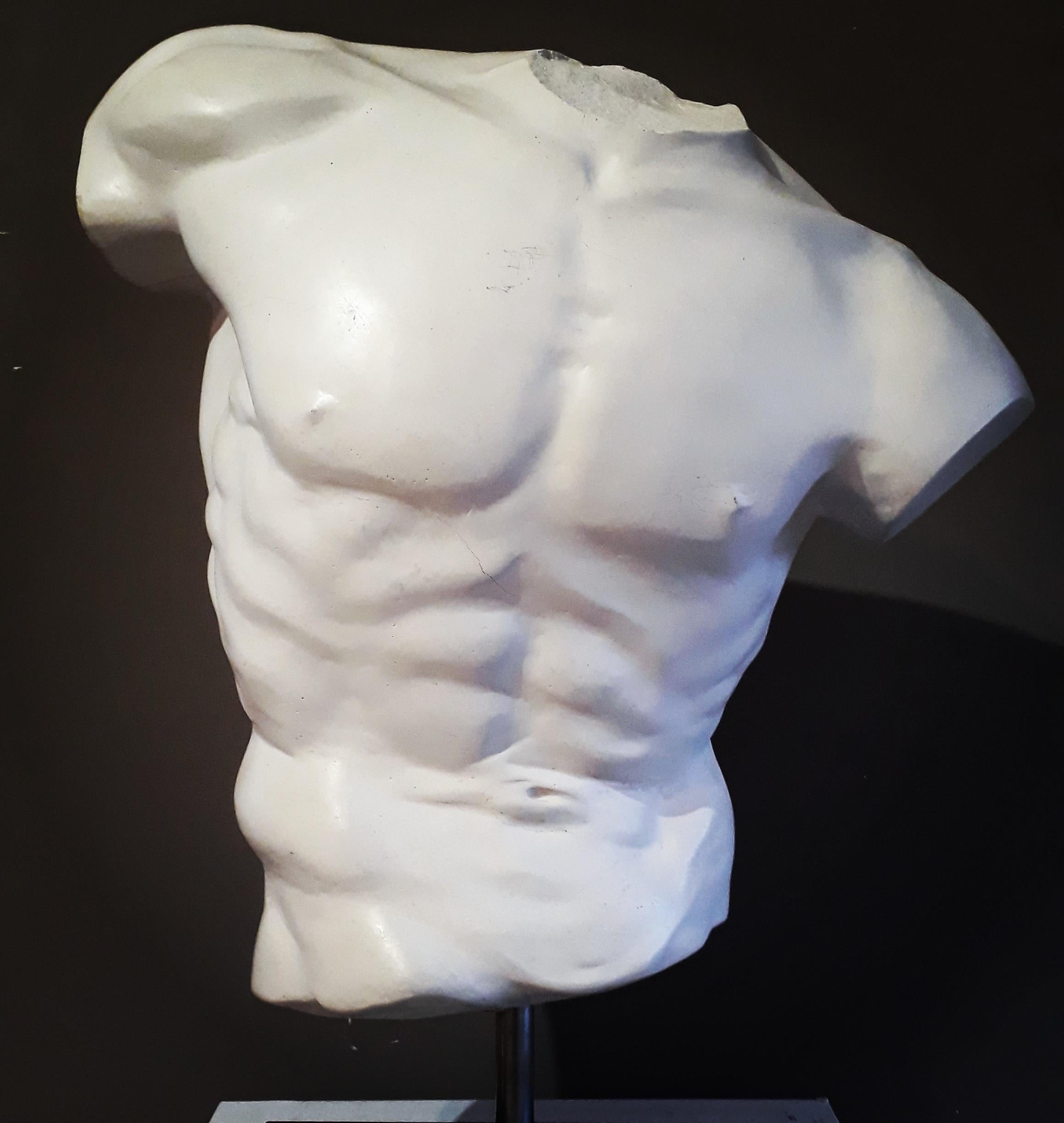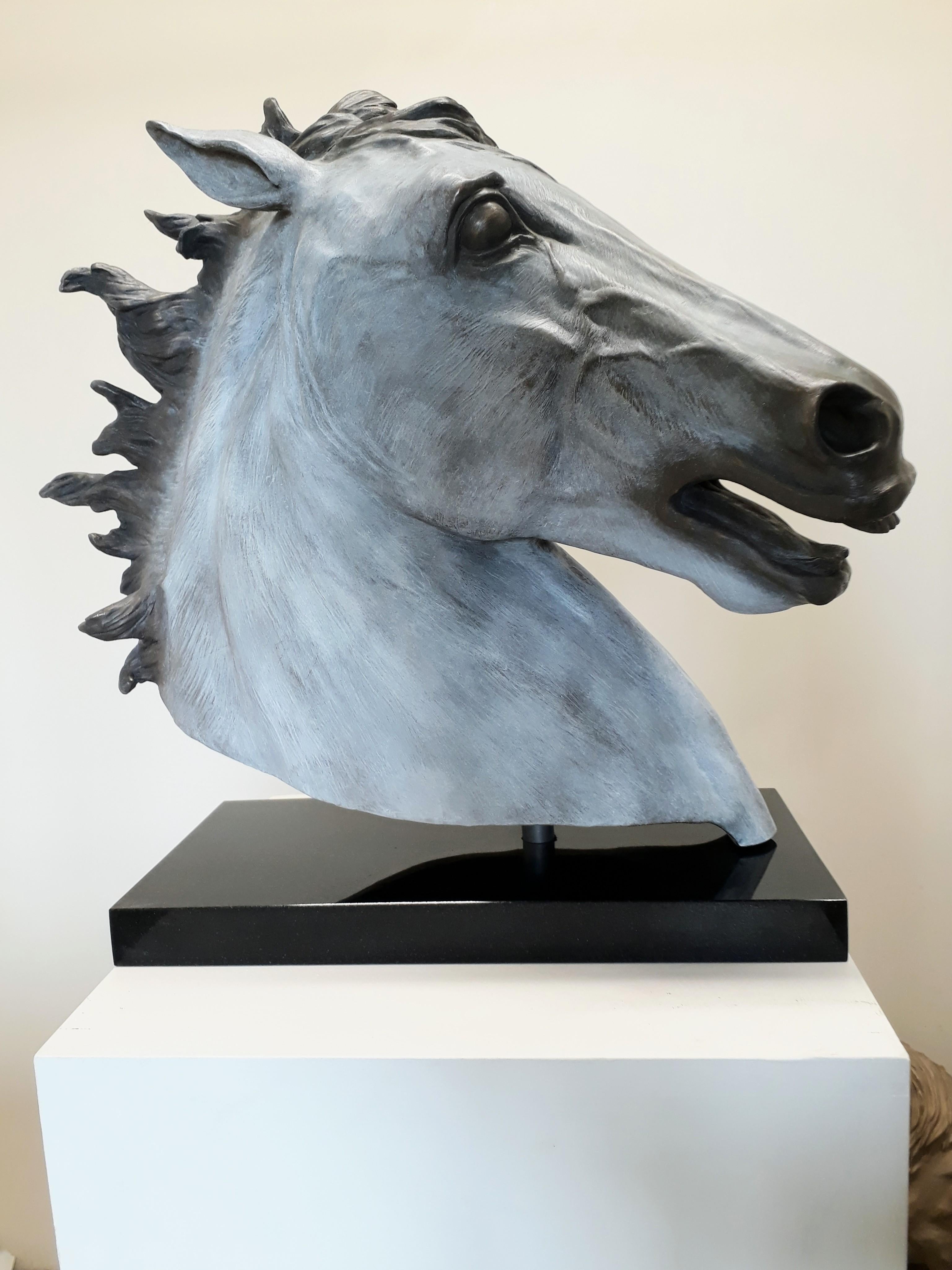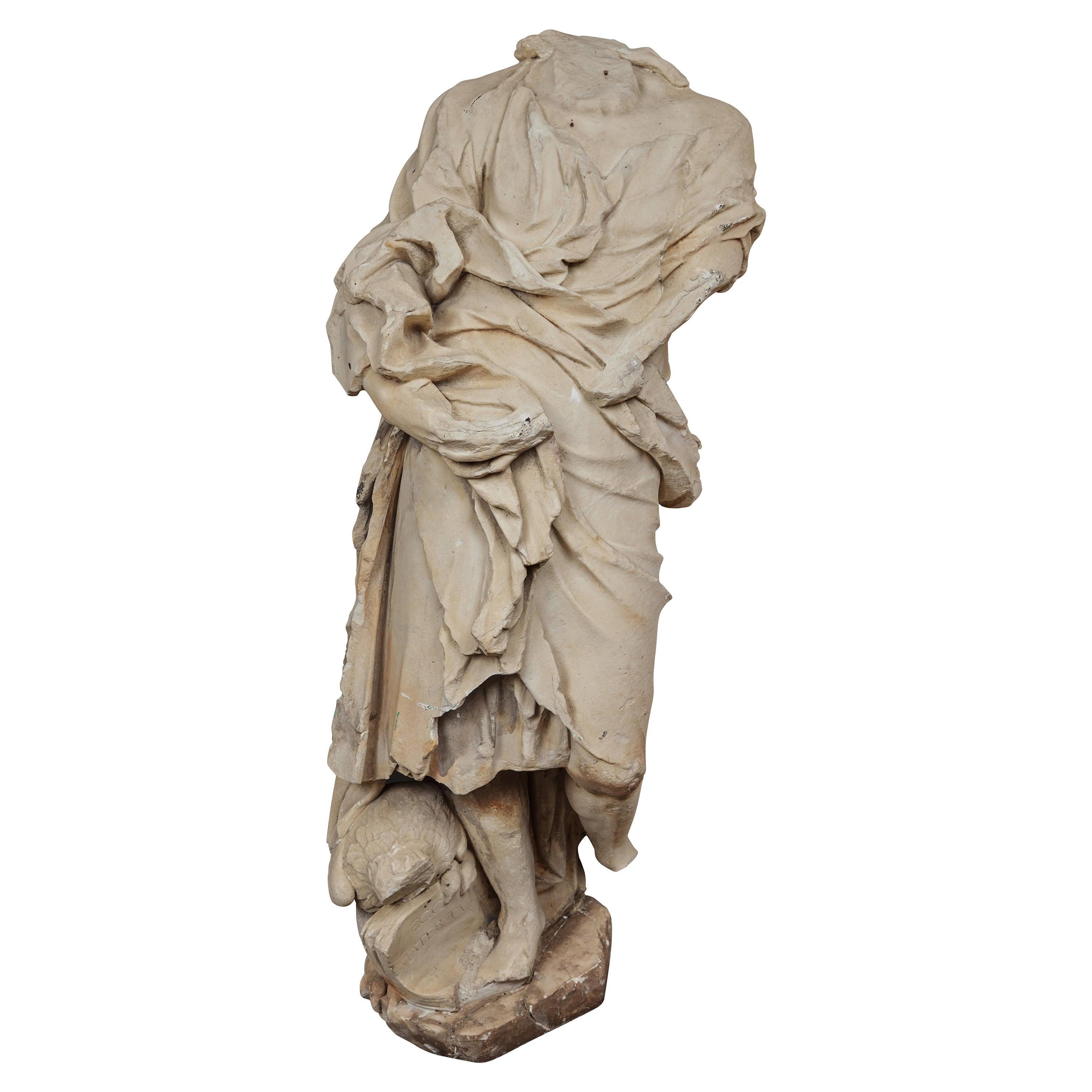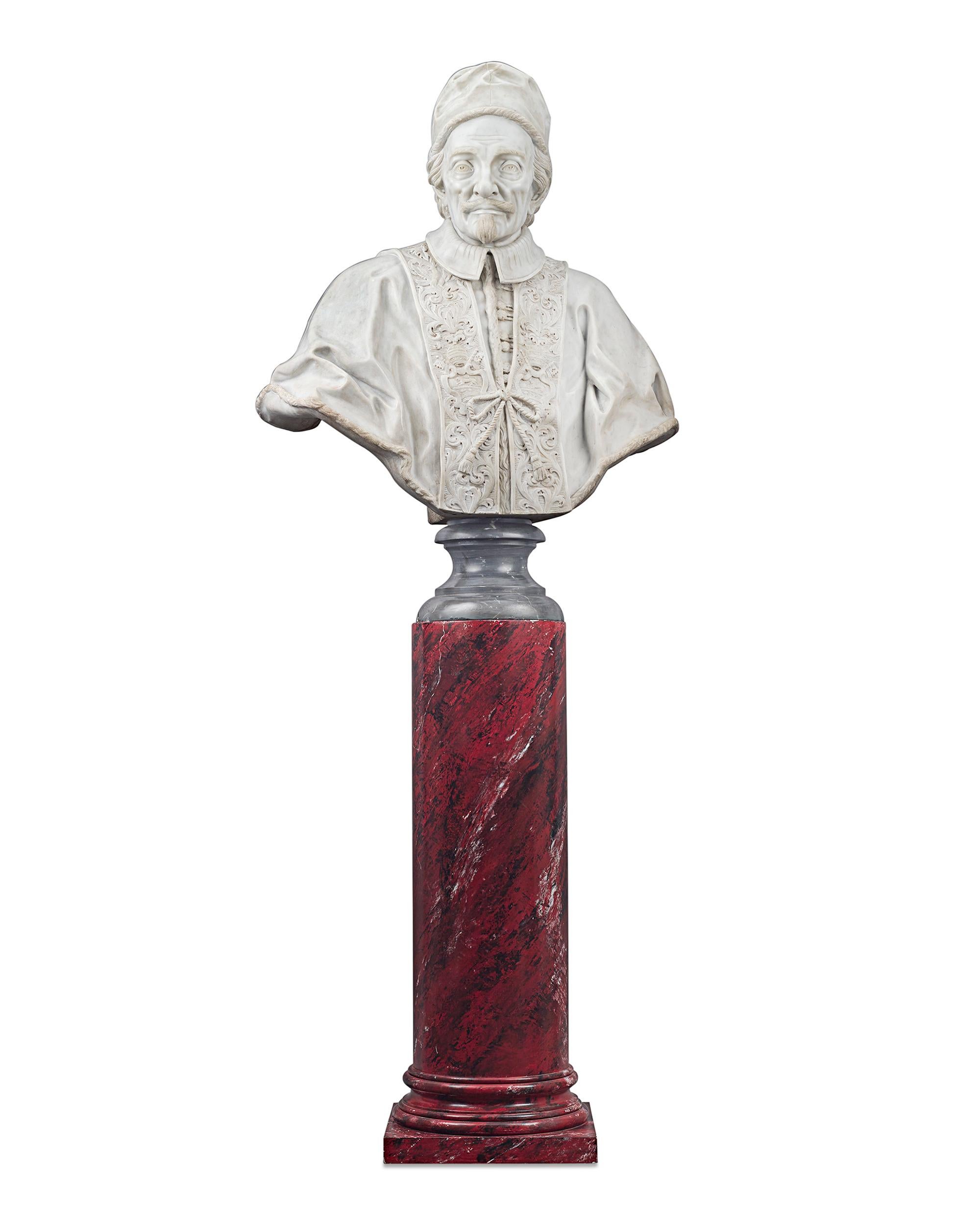Items Similar to Lamb
Want more images or videos?
Request additional images or videos from the seller
1 of 16
Barry DaviesLamb2022
2022
About the Item
This lamb is also featured in my statue of Saint David. It conveys such character and gentleness that I decided to present it as a sculpture in its own right. I lays on a base of black and gold marble called Portoro marble from the Gulf of Poets, in the Ligurian Province of La Spezia, Italy. I modelled the lamb during the spring which allowed me to study them first hand where I literally took physical measurements from them (when they kept still). Modelled in plaster, moulded in silicone rubber and cast in bronze using the lost wax process. The bronze casting was then sandblasted and hot patinated with the chemical titanium white and finished with liming wax.
- Creator:Barry Davies (1962, British)
- Creation Year:2022
- Dimensions:Height: 7.88 in (20 cm)Width: 14.18 in (36 cm)Depth: 9.06 in (23 cm)
- Medium:
- Movement & Style:
- Period:
- Condition:
- Gallery Location:Oswestry, GB
- Reference Number:1stDibs: LU2437211919122
About the Seller
5.0
Vetted Seller
These experienced sellers undergo a comprehensive evaluation by our team of in-house experts.
Established in 1989
1stDibs seller since 2023
Typical response time: 1 hour
- ShippingRetrieving quote...Ships From: Oswestry, United Kingdom
- Return PolicyA return for this item may be initiated within 14 days of delivery.
More From This SellerView All
- Discus Thrower's TorsoLocated in Oswestry, GBThis artwork emulates the classical statues from the ancient world, particularly with the head broken off at the base of the neck if carved in marble. In fact I went to the lengths o...Category
17th Century Baroque Figurative Sculptures
MaterialsGranite, Bronze
- Equus Caballus (modern horse)Located in Oswestry, GBThe evolutionary lineage of the horse is in palaeontological terms well documented. The natural history of the horse family Equidae began during the Eocene epoch 56 million to 33.9 million years ago starting with Eohippus (Dawn horse) evolving to Mesohippus , Merychippus, Pliohippus through to our modern...Category
2010s Baroque Figurative Sculptures
MaterialsGranite, Bronze
- Joan of ArcLocated in Oswestry, GBJoan of Arc is depicted here at a solo exhibition in St. Edwards chapel at St. David's Cathedral, South Wales. Hand carved from a solid block of Carrara marble imported from Italy, Davies used traditional tools also used by the master sculptors of the renaissance. She is life size and expresses purity of soul as you see her in Divine contemplation. This portrait bust sits proportionately on a marble socle, the design of which is from the classical Ionic order.Category
2010s Baroque Figurative Sculptures
MaterialsMarble
- Perseus and Fame proclaiming the birth of PegasusLocated in Oswestry, GBThis neo-classical style sculpture is of Perseus the son of Zues and Danae is ordered by King Polydectes to slay the gorgon Medusa. With the gift of a polished shield from Athena, a ...Category
Early 17th Century Baroque Figurative Sculptures
MaterialsBronze
- White tailed sea eagle and crabLocated in Oswestry, GBThis white tailed sea eagle is depicted here on a rock on the shore of a remote wild Scottish Isle (Outer Hebrides). Hiding beneath the rock is a brown crab...Category
16th Century Baroque Figurative Sculptures
MaterialsBronze
- GreyhoundLocated in Oswestry, GBWhat is unique about this artwork is the grace and elegance of the greyhound but designed in a most difficult stance frought with technical challenges. Yet the result offers a stance...Category
Early 17th Century Baroque Figurative Sculptures
MaterialsBronze
You May Also Like
- Pair of 19th Century Busts by Albert Ernest Carrier-BelleuseBy Albert-Ernest Carrier-BelleuseLocated in Santa Fe, NMSigned: A. Carrier-Belluese Two large bronze matching busts of an unknown male and female 22 x 10 x 11" male 23 x 10 x 9" female Both show signs of wear with their age but are in fa...Category
19th Century Baroque Figurative Sculptures
MaterialsMarble, Bronze
- Life Size Roman Marble FigureLocated in Newport Beach, CAA beautifully hand carved, full size Carrara marble figure of a boy. The robe is elegantly draped with clasps.Category
19th Century Baroque Figurative Sculptures
MaterialsMarble
- Renaissance Era Marble Figure FragmentLocated in Newport Beach, CAAn extraordinary 17th century, hand-carved, solid Carrara marble, life sized figure fragment on raised base of the same. The subject is swaddled in a luxurious, gathered robe and tun...Category
17th Century Baroque Figurative Sculptures
MaterialsMarble
- Bust of Pope Innocent XI Odescalchi by Domenico GuidiLocated in New Orleans, LAThis monumental bust is a museum-quality example of Roman Baroque sculpture. Crafted by the legendary Domenico Guidi and carved from Carrara marble, the impressive portrait captures the visage of Pope Innocent XI, Benedetto Odescalchi (1611-1689). It presents a larger-than-life example of Guidi’s remarkable skill as a sculptor, which ultimately made his workshop one of the most important in Rome during his age. Today, his works are rarely found on the market, particularly his extraordinary works in marble. Pope Innocent XI was born Benedetto Odescalchi into an Italian noble family of prominent bankers. Spending his early years in banking, he eventually turned to the law, earning his doctorate in 1639. His background would serve him well in his service to the papacy, and he became known as a frugal and devout member of the Church. In 1676, he was unanimously elected Pop after the death of Clement X. During his nearly 13-year reign, he instilled his own personal ideals of austerity and frugality onto the Church, with a deep commitment to reform and piety. He is captured here by Guidi in his traditional Pope’s mozzetta and camauro cap. A wide stole is draped over his shoulders, ornamented by acanthus leaves and the coat of arms of the Odescalchi family. It displays Guidi’s mastery over the chiaroscuro effect, particularly in the high level of contrast in his cheeks and his eyes, which Guidi achieved through various methods of high polish. A very similar portrait sculpture of Pope Innocent XI by Guidi can be found in the collection of the Royal Castle in Warsaw. The Warsaw bust belongs to a series of portraits of popes which the Odescalchi family commissioned from Domenico Guidi in the 1690s. Compared to that example, the present bust is far more dramatic, with deeper cut lines and a more precise expression. It is likely that the present piece was seen by the Odescalchi family, who ordered a similar one to be made. The piece was almost certainly intended to be displayed in a niche, given its dramatic cutting and its roughly carved back. Others of Guidi’s busts can be found in important collections throughout Italy, England and the United States, though many of these are lesser bronze repetitions. A bronze bust of the Pope Alexander VIII by Guidi is currently in the collection of the Victoria & Albert Museum (London), while a terracotta version of the same is in the Los Angeles County Museum. A bronze of Pope Alexander VIII can be found in the Princely Collection of Lichtenstein, and his impressive marble papal bust of Clement IX graces the pope’s tomb in Santa Maria Maggiore. The present bust of Pope...Category
17th Century Baroque Figurative Sculptures
MaterialsMarble
- Susanna al bagno Italian Marble Statue by Lombardi with relief sculpture BaseBy Giovan Domenico Lombardi OminoLocated in New York, NYGIOVANNI BATTISTA LOMBARDI (ITALIAN, 1822-1880) A fine marble statue titled Susanna al Bagno sitting on a revolving pedestal carved in relief with...Category
Mid-19th Century Baroque Nude Sculptures
MaterialsMarble
- Maqueta las toninasLocated in Miami, FLMaqueta las Toninas, 1944 BMY-022, 1970 Edition 1/25 Bronze 22 x 22 x 10 cm 8.6 x 8.6 x 3.9 in ABOUT THE ARTIST Narvaez was born in Porlamar, Venezuela, in 1905; he was the fifth son of eleven siblings; his parents were Jose Lorenzo Narvaez and Vicenta Rivera. Don José Lorenzo, a multifaceted and creative man, sowed the seed of creativity in his son. “My father did not fit in with his fantasies of cabinetmaker, bricklayer, master builder, and self-taught architect.”1 From an early age, Francis was led to the artistic activity, he traced, carved, made replicas of the furniture and the saints restored by his father. In 1920 he obtained his first professional assignment, a San Rafael for the Church of Carupano, and, in 1922, his father authorized him to travel to Caracas to pursue his studies as an artist. He studied at the atelier of Marcos Castillo, at of the Angel Cabre y Magriña and at the Academy of Fine Arts in Caracas, where he was introduced to the painters and intellectuals of the time. In 1928 he presented his first solo exhibition at the Club Venezuela. With the money raised from the sale of the works and the support of Monsignor Sosa, and the Ministers Centeno Grau and Arcaya, he studied in Paris on a scholarship. Once there, he enrolled at the Académie Julian, where Tito Salas, Cristóbal Rojas and Arturo Michelena had also studied. It was in Paris where, unable to work in wood, he turned to stone carving. “In Paris, I didn’t have wood, so I carved a lot in stone (…), when there were demolitions I purchased chunks of stone, I would take them to the workshop and carve them.”2 His first attempts at volumetric sculptures and painting in plain colours, linked to the thematic of American miscegenation and Creole reality, can be traced back to that first trip to Paris. During his stay in the French city, Arturo Uslar Pietri, Alfredo Boulton, and Finita Vallenilla supported the artist both financially and logistically, and in February of 1930, the trio of friends arranged another exhibition for him at the Club Venezuela. Narvaez describes his exhibition as follows: “(…) in it I feel that the sculptural work is more my own, done with more assurance, a response to my pursuit of large planes, stylisation and synthesis.”3 By then, as Boulton himself noted in his book about the artist, Narvaez departed from most of the artistic traditions that prevailed by that time in Venezuela. In 1931 he returned to Caracas and established his atelier at the Barrio Obrero in Catia. The atelier became the hub of the intellectual life of the time. “In those years, the atelier of Francisco Narvaez was the hub of the greatest Venezuelan hope. Nothing comparable to it can be found either before or since.”4 From that year onwards, exhibitions, projects, trips, and awards we multiplied. He was awarded the President of the Republic of Venezuela Prize, the National Sculpture Prize of the 1st Official Venezuelan Art Salon, and the John Boulton Prize of the 3rd Annual Venezuelan Art Salon; for the Military Academy, he produced a spectacular relief entitled La Patria. In 1945, commissioned by the architect Carlos Raúl Villanueva, he produced two groups of sculptures known as Las Toninas, both located in the O’Leary Square. There, as he himself states, he incorporates some baroque patterns into the figures to the source itself: “It is a work of balance between the decorative requirements and the sculpture of planes and angles.”5 In 1948 he was awarded the National Painting Prize. In the same year, he was called upon by the architect Carlos Raul Villanueva to participate in the project for the arts integration in the Universidad Central de Venezuela. Francisco Narvaez’s public output continued with works such as the statue of Fermín Toro, La Educacion, La Ciencia, three murals (produced by María Luisa Tovar) for the Instituto de Medicina Experimental, El Cristo; el Atleta, the equestrian statue of General Rafael Urdaneta. In 1953 he was appointed Director of the School of Plastic and Applied Arts, and in July of the same year, he exhibited “Francisco Narvaez, Maderas, Piedras y Bronces” (Francisco Narvaez, Woods, Stones and Bronzes) at the Museum of Fine Arts. Narvaez is, unquestionably, one of the great Venezuelan sculptors, his work goes through various stages and interests; as the art world evolves, the artist does not remain in his initial scopes of work. His creations are not imposed by the prevailing trends or fashion but do evolve by experimenting with new materials and interests. When one peruses the artist’s lengthy list of exhibitions, commissions, and awards, it is worth remembering the Narvaez who embark on his career as a child and who, overcoming obstacles, knew how to make the most of his curiosity. He did not settle for living off his successes. He did not remain stagnant as many creators of his environment did. Narvaez managed to understand the changes in the history of art around him. We must not overlook the fact that Francisco Narvaez is an artist amid all the changes occurring in the art world. He moves from the classics to the great transformations in the art world. It is the Europe of Picasso, Braque, Arp. He observes, he is aware of what is happening in the centres of the world of art, but between his craft and his sensitivity, the result is NARVAEZ, his stamp, and his identity. Francisco Narvaez comes from tradition, and his first stage is linked to the classics, to the exploration of his heritage, but always with his very own language. Throughout his prolific career, he knew how to remain true to himself, without disregarding the influences of his surroundings or his artistic interests: his ability as a sculptor, his selection of materials, whether they were wood, stone or bronze; his choice of the subject of his work…His mastery and great craftsmanship are a constant that over time have made him a leading player in the history of contemporary Venezuelan and world art. From his beginnings, no subject was foreign to him. His paintings, drawings, aquarelles, and sketches are testimony to his prolific output. Among his themes are portraits, our traditions, still lifes, and landscapes. Narvaez is an artist who represents his time. Later, he evolved towards purer and simpler forms, abandoning figurative art for short periods. In 1956 he declared to the newspaper El Nacional: “Every day I am freeing myself, it is a soul that frees itself from the ephemeral wrappings of the circumstantial always, as well as from the inevitable weight of the anecdote. This second stage of my work is remarkably close to abstractionism, even if there are still certain figures or figurations in the sculptures that I will shortly be showing. However, pure, and absolute abstractionism, it will treat the form itself as the sole reason for its existence on the plane of artistic excellence.”6 The artistic development was his professional life. Each period of his life as an artist, he went one step further, searching, solving, seeing plenty of things and understanding how diverse expressions were transforming themselves. His hands followed his gaze and his mind, always inquisitive. He added movement to the volumes. Arturo Uslar Pietri, “Formas Nuevas”, Cromotip editions, 1956 “Francisco Narvaez is a path: the path that Venezuelan sculpture...Category
1940s Baroque Figurative Sculptures
MaterialsBronze
Recently Viewed
View AllMore Ways To Browse
Black And Gold Marble
Gold Lamb
Statue Of Saints
Bronze Lamb
Lay Models
Black And White Baroque Art
Baroque Bronze Sculpture
Plaster Cast Art Model
Baroque Marble Sculpture
Marble David Sculpture
Marble Sculpture Of David
Plaster White Gold
Portoro Marble Base
Patinated Plaster Sculpture
Baroque Plaster
Lime Plaster
David Marble Statue
Lamb Statue





